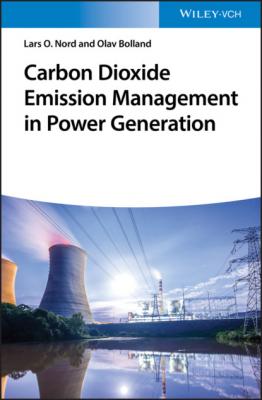Carbon Dioxide Emission Management in Power Generation. Prof. Lars O. Nord
Читать онлайн.| Название | Carbon Dioxide Emission Management in Power Generation |
|---|---|
| Автор произведения | Prof. Lars O. Nord |
| Жанр | Химия |
| Серия | |
| Издательство | Химия |
| Год выпуска | 0 |
| isbn | 9783527826650 |
For a much longer time frame, data from the Vostok ice core provide an insight into the variations in CO2 levels for the past four glacial–interglacial cycles. In January 1998, the collaborative ice-drilling project between Russia, the United States, and France at the Russian Vostok station in East Antarctica yielded the deepest ice core ever recovered, reaching a depth of 3623 m (Petit et al. 1999). Data from this project are displayed in Figure 1.1. One conclusion from the authors was that present-day atmospheric burdens of CO2 seem to have been unprecedented during the past 420 000 years. Note that the mean resolution for the CO2 measurements was about 1500 years.
1.3 Natural Accumulations and Emissions of CO2
There are many examples of natural emissions of CO2 to the atmosphere. Forest fires and grass fires are natural phenomena, which release large amounts of CO2 to the atmosphere. On the other hand, after such fires, new trees and grass will grow and eventually bind more or less the same amount of CO2 as was released. One can say that as long as the total amount of biomass on a global basis is constant over a longer period of time, the combustion, decay, and growth of biomass is balanced with respect to CO2. In this respect, the use of biomass for energy purposes can be regarded as CO2 neutral. Consequently, if the amount of biomass is increasing through an expansion of the area covered by forests, this contributes to reducing the amount of CO2 in the atmosphere. In reality, there is a significant ongoing reduction in biomass globally by man-made forest fires and wood cutting, which contributes to about 20% of the annual increase in greenhouse gas emissions.
Figure 1.1 Vostok ice core data for 420 000 years. Atmospheric CO2 concentrations from trapped gas bubbles.
Source: Petit et al. (1999). Reproduced with permission of Springer Nature.
There are also a number of examples of seepage of CO2 from the ground. From many of the ground seepages, the flux is so small that it is hardly noticeable. Others have a high flux so that the ground-level concentration can cause death of plants through ‘root anoxia’ and even pose risks to human health and safety. At concentrations above about 2%, CO2 has a strong effect on respiratory physiology, and at concentrations above 7–10%, it can cause unconsciousness and death. Exposure studies have not revealed any adverse health effect from chronic exposure to concentrations below 1% (Fleming et al. 1992).
One important aspect to note about CO2 is that it has a higher molecular weight than air, meaning that it is denser than air. As a consequence, the release of CO2 at a low point in the terrain, with little or no wind, can cause the concentration at that point to increase to a very high level, as the CO2 will not be transported vertically by buoyancy.
Seepage of CO2 from the ground has a relevance to CO2 capture and storage because stored CO2 may leak out to the atmosphere. The impact on human health from releases of CO2 can be severe. Some examples are Lake Monoun, Lake Nyos, and Lake Kivu, which are the only three lakes in the world known to be saturated with CO2 (Clarke 2001; IEA-GHG 2006). The former two are located quite close to each other in the Oku Volcanic Field in Cameroon, whereas the latter is in Rwanda. In these lakes, the content of CO2 per volume of water increases with depth because the solubility of CO2 in water depends on the pressure, as can be seen in Figure 4.17.
On 15 August 1984, Lake Monoun exploded in a limnic eruption probably caused by an earthquake, which resulted in the release of a large amount of CO2. As a direct consequence of the release, 37 people were killed. A gas cloud came up from a crater in the eastern part of the lake
